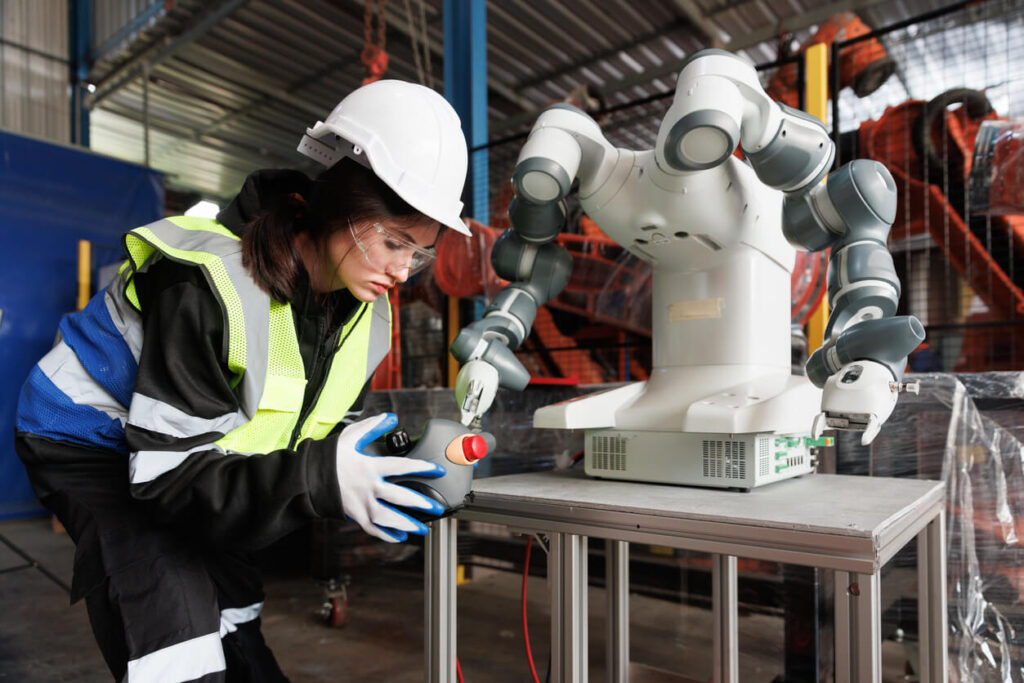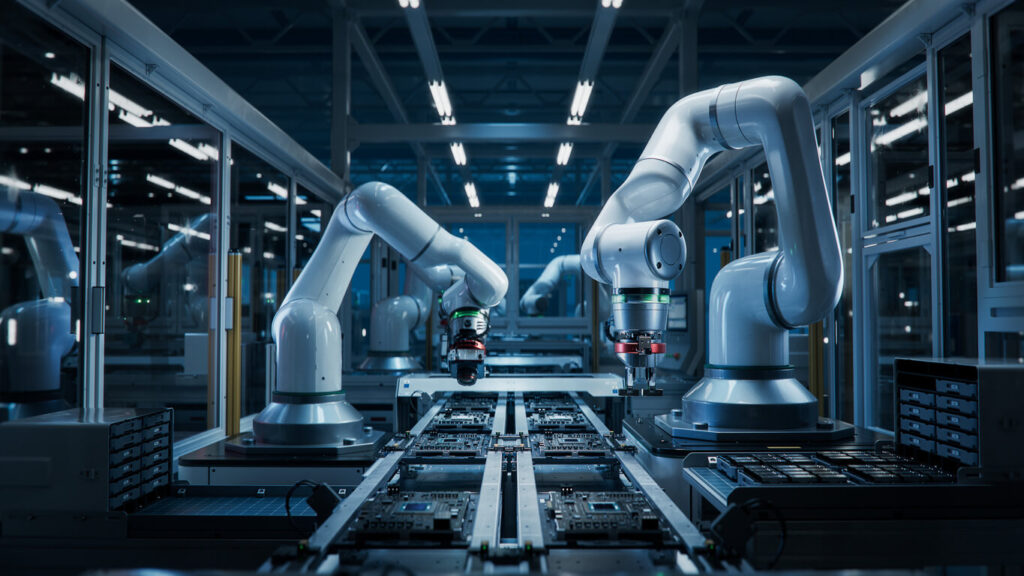Although the manufacturing sector is still the biggest purchaser of robots, there are now huge commercial opportunities arising for ‘service robots’. This is in part driven by the number of new start-ups, which currently account for approximately 29% of all the robot companies in operation.
An Introduction to Service Robots
ISO 8373 defines a ‘service robot’ as a robot ‘that performs useful tasks for humans or equipment, excluding industrial automation applications’. According to ISO 8373, service robots require ‘a degree of autonomy’, or the ‘ability to perform intended tasks based on current state and sensing, without human intervention’. The growth in service robots is based on the emergence of ‘cobot’. These are enabled by innovations in AI and sensor technology.

There have been huge advances recently in deep learning, a branch of AI involving building artificial neural networks which attempt to mimic the way organic (living) brains sort and process information. Deep learning is driving innovation at the cutting edge of AI and it can be seen in many applications today, including speech and image recognition.
Robots in Healthcare
Healthcare and process manufacturing are high-growth sectors in robotics, with spending here increasing dramatically. Medical diagnostics is one particular field where AI is enabling rapid advances, with prospective applications including:
- Chatbots: Companies are using AI chatbots with speech recognition capability to identify patterns in patient symptoms and make a potential diagnosis.
- Oncology: Researchers are using deep learning to train algorithms to recognise cancerous tissue at a level comparable to trained physicians.
- Pathology: Pathology is concerned with the diagnosis of disease based on the laboratory analysis of bodily fluids such as blood and urine, as well as tissues. Machine vision and other machine-learning technologies can enhance the efforts traditionally left only to pathologists with microscopes.
- Rare diseases: Facial recognition software is being combined with machine learning to help clinicians diagnose rare diseases. Patient photos are analysed using facial analysis and deep learning to detect phenotypes that correlate with rare genetic diseases.
Service robots are also having a significant impact in areas such as agriculture, surgery, logistics and underwater applications, and the maintenance, security and rescue market.
Projects, Applications and Enabling Technologies
A growing number of companies, both start-ups and established players, are developing service robots, with applications across a number of industries.
Collaborative robotic concept
Medineering GmbH (as part of Brainlab now) has developed a collaborative robotic concept that specifically targets the needs of surgeons. Today, surgeons often require the support of a sufficiently trained assistant to position and hold instruments during surgical interventions. The Medineering solution consists of an easy-to-guide Positioning Arm with a mechatronic interface at its end, allowing a variety of surgical robots to be attached to it. The first robot Medineering offers is an Endoscope Guidance Robot, which holds the endoscope during endo- and transnasal interventions.
The Positioning Arm, with its seven joints, can be positioned exactly as required using the touch buttons on its surfaces. Once in place, the position can be saved. Fitted to the end of the arm is the Endoscope Guidance Robot, which is then controlled by the surgeon using a foot pedal during the operation. The robot is designed to make fine movements of low intensity, enabling tremor-free positioning and accurate avoidance of sensitive tissue.
This approach relieves the surgeon or assistant from the task of holding the endoscope, so that surgical resources can be used more efficiently. This reduces the time of such interventions or releases medical support staff for other duties, which leads to cost savings. The Medineering Positioning Arm is also open for approved partners to develop further surgical robots to be fitted, making it useful in other areas of surgery.
Robotic ‘spider’
In the field of hazardous environments, Forth Engineering Ltd’s prototype robot has been developed to address a critical issue concerning the treatment of nuclear waste at the Sellafield nuclear site in Cumbria. Forth was collaborating with the University of Manchester to leverage the university’s world-leading research in nuclear waste management while developing its robotic ‘spider’. The ‘spider’ is actually a six-legged robot, about the size of a coffee table, and bristling with cameras and sensors, enabling it to see its environment.
A large front-mounted pincer grabs and breaks up contaminated material. The robot can crawl up walls using magnets on its feet, and AI software allows a team of the robots to work autonomously, communicating with one another and making their own decisions on how to best complete a task.
Industry 5.0 and Human-Robot Collaboration
Industry 4.0 has been termed the next phase of the Industrial Revolution, characterised by the ‘smart factory’, in which cyber-physical systems monitor the factory processes and make decentralised decisions. Whereas the most recent advancement in industrial revolution is Industry 5.0 which defines collaboration between humans and robots.

Collaboration – inter-robot and between robots and humans – is a key enabler of the smart factory, allowing people and robots to each contribute their unique strengths: people providing insight and improvisation, and robots offering speed and repetition.
Retailer Ocado’s prototype ARMAR-6 robot is an example of this type of collaborative robot, or ‘cobot’. ARMAR-6 has been developed with support from four European universities. The robot has a human-looking torso, arms with eight degrees of freedom, hands that can grip and a head with cameras inside. Designed to help engineers fix mechanical faults in its factories, ARMAR-6 uses a three-camera system inside its head to help it detect and recognise humans and objects. Speech recognition helps it understand commands and its hands are able to pick up and grasp objects. The ultimate goal is for the robot to be able to decide what the technician’s intentions are and contribute as appropriate at the right point in time.
Ethical and Moral Considerations
Advances in AI and robotics have rekindled two long-standing fears: that machines will cause mass unemployment, and that there will be a Terminator scenario in which robots will ‘wake up’ and do unintended things.
A fierce debate is underway with concerns expressed by, among others, the late Stephen Hawking and Elon Musk, the technology entrepreneur. The more optimistic viewpoint is that throughout history technology has created more jobs than it has destroyed, albeit with some disruption to society, such as the migration of jobs to the cities during the Industrial Revolution.
As ever the truth will probably lie somewhere in between. While AI might not cause people to lose jobs, it will certainly create disruption in the labour markets, requiring workers to learn new skills more quickly than in the past. This view is supported by a recent study on the German economy, which has shown that employees in operations deploying robots tend to keep their jobs and benefit from upskilling. At the same time these operations have reduced the number of new hires, leading to a shift in employment away from manufacturing and into other sectors.
A report from Citi, produced in conjunction with the University of Oxford, has highlighted the risk of increased automation leading to greater inequality as AI impacts on traditional blue-collar jobs more than white-collar jobs. This highlights the important role of companies and governments in making it easier for workers to acquire new skills and switch jobs as needed. Citi identifies investment in education as the single biggest factor that could mitigate the impact of increased automation and AI.

As with any tool, AI has the potential to be used in both benign and sinister applications. While deep learning has the potential to fight crime it can also allow authoritarian governments to spy on their citizens. Self-driving cars raise other ethical issues, particularly when it comes to how they should behave in emergencies – should the vehicle risk injuring its occupants to avoid hitting a child who steps out in front of it? Find out why robots will be better drivers than humans here.
Conclusion
Rapid advances in AI supported by a surge in investment have contributed to a growth in the number and types of robotic applications now being realised. Service robots are set to play an increasingly important role in our day-to-day lives, facilitated by their flexibility and enhanced decision-making capabilities.
With analysts and commentators divided on how these developments will impact upon our society, the consensus is that conscious intervention is required from governments to regulate and manage the disruption to labour markets which will be caused by this technology.
To find out more about robotics, read our Guide to Robots and Automation and learn more about robotics software, Industry 5.0 and how to implement robotics into your business.











